Nvidia GeForce GTX 1050 3GB Review: (Mostly) Faster Than 1050 2GB
Why you can trust Tom's Hardware
Conclusion
Nvidia’s GeForce GTX 1050 3GB isn’t just an arbitrary addition to the company’s Pascal-based graphics card family. Rather, it’s meant to gradually replace GeForce GTX 1050 2GB, which utilizes 4Gb of GDDR5 memory that’s purportedly getting harder to source. Introducing a different configuration designed with 8Gb densities in mind gives board partners more flexibility, while also pushing performance higher in most of the games we tested.
For that reason, we aren’t particularly bothered that a GP107 processor with 768 CUDA cores and a 96-bit memory bus shares a model name with the original 640-core/128-bit version. This is much less egregious than rolling out a GeForce GT 1030 with DDR4, cutting memory bandwidth by 65% (or quietly introducing a Radeon RX 560 with 14 Compute Units instead of 16). Give us more performance any day of the week. Just don’t take it away without abundant clarity.
Of course, our favorable reception of GeForce GTX 1050 3GB hinges on pricing that puts it in the same league as GeForce GTX 1050 2GB. Multiple sources tell us this is the plan. But then again, GeForce GTX 1050 2GB starts at $140 today. In 2016, it debuted at $110. Forgive us for extreme cynicism when it comes to claims concerning costs.
One issue we do have with GeForce GTX 1050 3GB—at least the sample we tested—is its tendency to exceed the PCI-SIG’s 5.5A maximum over a motherboard’s slot connector. Spikes in the 5.8 to 5.9A range are far less severe than the 6.74A we originally observed from Radeon RX 480. However, it’s still higher than GeForce GTX 1050 2GB or 1050 Ti 4GB, both of which abide the specification.
After a taxing year of inflated graphics card prices and tenuous availability, enthusiasts are unquestionably ready to herald the next generation of gaming hardware, particularly at the high end where we’d love to see a single-GPU solution able to drive new 4K displays. Lower-end cards like GeForce GTX 1050 generally show up months later, though. No doubt, it’ll be a while before anything replaces GP107. A 3GB variant of GeForce GTX 1050 stands to weather time more gracefully than a 2GB configuration reliant on lower-density GDDR5. And if 3GB cards do indeed show up at 2GB pricing, we’ll have to rethink Radeon RX 560’s position as our top recommendation for FHD gaming.
MORE: Best Graphics Cards
MORE: Desktop GPU Performance Hierarchy Table
Get Tom's Hardware's best news and in-depth reviews, straight to your inbox.
MORE: All Graphics Content
-
caledbwlch Any chance we can get a comparison of the 1050 3GB with the memory overclocked in comparison to the 1050 Ti?Reply -
dudmont These 1050s are begging for some OEM to add a 6pin PCIE connector and rework the power limits on the cards. With good cooling, I'm betting 2GHZ isn't out of the question, with a good GPU.Reply -
King_V bit_userReply
Well, our somewhat opposing speculations when the 3GB version announced pretty much are BOTH confirmed with this test.
Sometimes it achieves parity with the 1050Ti, and sometimes it dips below 1050 performance.
Depends on the game.
One thing neither of us considered in our conversation - the need for higher clocks pushes up power consumption to the point where spikes occasionally exceed the specs for the PCIe slot.
Still, the results are interesting - and my curmudgeonly side somewhat objects to the idea of cutting memory bandwidth and compensating for it by cranking up the power. -
Giroro Since this is basically an overclocked 1050 ti with one memory chip missing, I figure it should be no problem to overclock any 1050 Ti to the same rate as the 1050 3GB.Reply -
BulkZerker @redgarlReply
Second paragraph of the article.
"According to our sources, it really doesn’t. Slowly but surely, GeForce GTX 1050 3GB cards will start replacing 2GB boards, particularly as the 512MB memory chips used on those 2GB implementations become harder to source. " -
cangelini Reply21079032 said:Any chance we can get a comparison of the 1050 3GB with the memory overclocked in comparison to the 1050 Ti?
I've been playing with this a bit. Wanted to get the GDDR5 fast enough to give 112 GB/s but realistically it's going to take down-clocking the 1050 2GB, overclocking the 3GB card, and then seeing what difference the missing ROP partition/L2 makes. Will continue trying to come up with a good comparison. -
cangelini Reply21079785 said:Better to test the real product when it shows up. Things must be slow at Tom's.
It *is* a real product. There's a model number and everything :) I've been itching to do something with graphics for months!

